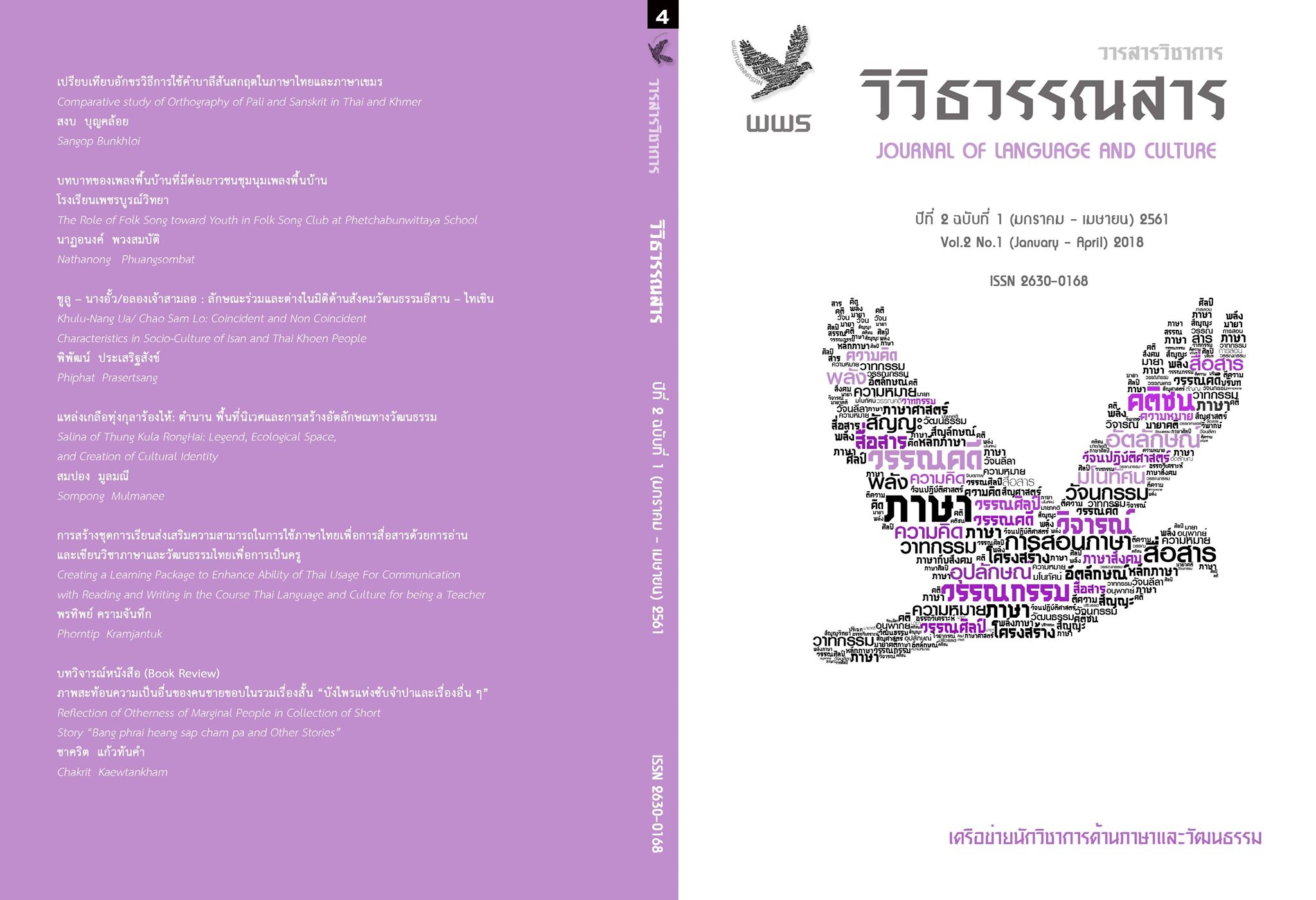แหล่งเกลือทุ่งกุลาร้องไห้ : ตำนาน พื้นที่นิเวศและการสร้างอัตลักษณ์ทางวัฒนธรรม
Main Article Content
บทคัดย่อ
บทความนี้มุ่งกล่าวถึงตำนานพื้นที่นิเวศและการสร้างอัตลักษณ์ทางวัฒนธรรมแหล่งเกลือทุ่งกุลาร้องไห้สาระสำคัญสรุปได้ว่าเกลือสินเธาร์ ในบริเวรทุ่งกุลาร้องไห้มีความสำคัญต่อวิถีผู้คนในฐานะเป็นตำนานศักด์สิทธ์ประจำพื้นที่ทุ่งศรีภูมิอำเภอสุวรรณภูมิ จังหวัดร้อยเอ็ด ซึ่งปัจจุบันยังคงเห็นว่าน้ำบริเวณเป็นแหล่งน้ำเค็ม และพื้นที่พื้นที่บริเวรนี้ยังสามารถขูดเอาดินมาต้มเกลือได้ในทั่วไปจนก่อให้เกิดอุตสาหกรรมรถของลุงเหล็กการทำอาวธุตีมีด ในบริเวณใจกลางทุ่งกุลาร้องไห้มาตั้งแต่ยุคประวัติศาสตร์ทวารวดีเครื่องมือทางวัฒนธรรมที่สำคัญยิ่งในการปกป้องแหล่งทรัพยากรธรรมชาติ โดยมีตำนานเจ้าพ่อผู้รักษาพื้นที่ อันนำมาซึ่งการกำหนดเขตพื้นที่ศักดิ์สิทธิ์ และพิธีกรรมศักดิ์สิทธิ์ที่เกี่ยวข้องกับความเชื่อเรื่องเจ้าพ่อ ความเชื่อและพิธีกรรมเหล่านี้เป็นเครื่องมือในการสร้างพื้นที่เชิงนิเวศวัฒนธรรม กำหนดอัตลักษณ์ทางวัฒนธรรมให้กับคนในพื้นที่ทุ่งศรีภูมิ จังหวัดร้อยเอ็ดให้มีความโดดเด่น และขนานนามตนเอง ว่า “คนทุ่ง” อันมาจากความเป้นเอกลักษณ์ทางวัฒนธรรมของผู้คนตามแหล่งทรัพยากรเกลืออย่างแท้จริง
Article Details
ลิขสิทธิ์ของบทความเป็นของวารสาร การพิมพ์ซ้ำจะต้องได้ร้บการอนุญาตจากบรรณาธิการวารสาร
เอกสารอ้างอิง
laksana kan yuem kham lae kan plian plaeng khwam mai
khong kham thap sap. (In Thai) [English loan words: A study of
the characteristics of loanwords and the changes in the meanings
of transcribed words]. Master's thesis (Thai language), Faculty of
Humanities and Social Sciences, Naresuan University.
Chaikiettham, R. (2013). Kan wikhro lae priap thiap kham yuem
phasa Aungkrit thi prakot nai phasa Thai lae phasa Chin.
(In Thai) [An analysis and comparison of English loan words seen in
Thai language and Chinese language]. Bangkok: National Research
Council of Thailand.
Jampa, P. (2012). Sunthariya withi khong Kham yuem phasa Aungkrit
nai phra ratcha niphon rueang Klai Ban. (In Thai). [Aesthetic
techniques for English loan words in King Rama V’s Klai Ban].
Retrieved from http://human.bsru.ac.th/search/sites/default/files/
Kingkham, W. (2007). Phasa tang prathet nai phasa Thai. (In Thai)
[Foreign languages in Thai language]. Bangkok: Kasetsart
University Press.
King Rama V. (1920). Phra ratcha hatthalekha suan phra ong somdet
phra ramathipbodi si-sin maha-chulalongkon phra
chunlachom klao chao yu hua song mi phra ratchathan dae
somdet phra si phatcharin thra boromma rachininat phra
borom ratchonnani nai wela thi song samret ratchakarn
phaen din tang phra ong muea sadet praphat yurop
pho.s.o 2440. (In thai) [His Majesty’s letters to Queen Sri Bajarindra
during His Majesty’s first visit to Europe in 1897]. Bangkok: Sophon phiphatthanakorn.
Kongsirirat, S. (2016). Khwam than samai khong phra bat somdet phra
Chunlachomklao chao yu hua. (In Thai) [The modernity of King
Chulalongkorn]. Journal of Liberal Arts, 16(2), 61-88.
Merriam Webster Dictionary. (1828). Retrieved October 15, 2017 from
https://www.merria m-webster.com/
NECTEC. (2009). English-Thai dictionary: NECTEC’s Lexitron Dictionary.
Retrieved from https://dictionary.sanook.com/search/dict-en-thlexitron.
Onprasert, B. (1990). Kham yuem phasa Aungkrit nai chot mai het Thai
samai ratchakan thi 3-5. (In Thai) [English loanwords in Thai
reports during the reigns of King Rama 3-5]. Master's thesis
(Thai Epigraphy), Faculty of Archeology, Silpakorn University.
Piamngam, P. (2011). Kham yuem nai phasa Thai. (In Thai) [Loan words
in Thai language]. Bangkok: Department of Eastern Languages,
Faculty of Arts,Rajamangala University of Technology Lanna,
Phitsanulok Campus.
Royal Institute. (2013). Photchananukrom chabap ratchabandit
tayasathan pho.so.2554. (In Thai) [The 2011 Office of the Royal
Society Dictionary]. Bangkok: Office of the Royal Society.
Saengjan, M. (2011). Wikhro Kham yuem phasa Aungkrit chak
nangsue phim. (In Thai) [An analysis of English loan words in
Newspapers]. Independent Study (Thai language),
Naresuan University.
Setthabut, S. (n.d.). Photchananukrom plae Aungkrit Thai. (In Thai)
[English-Thai Dictionary]. Retrieved from http://dictionary.sanook.
com/search/dict-en-th-sedthabut
Taileart, N. (2015). Kan seuksa kham yuem phasa Aungkrit nai phra
niphon rueang san somdet khong somdet chao fa krom
phraya Naritsara Nuwattiwong lae somdet krom phraya
Damrongrachanuphap. (In Thai) [A study of English loan words
in “Somdej’s Messages” by Somdej Chaofa Kromphraya Naritsara
nuwattiwong and Somdej Kromphraya Damrongrachanuphap].
Master's thesis (Thai language), Thai Language Program, Faculty of
Humanities, Naresuan University.
Thiangburanatham, W. (2002). Photchananukrom Thai - Aungkrit.
(In Thai) [Thai-English Dictionary (Library Edition)]. Bangkok:
Aksornphittaya


